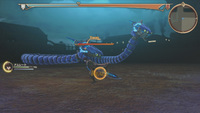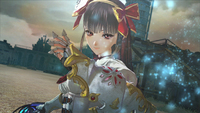|
|

|
PLATFORM
|
Vita
|
BATTLE SYSTEM
|

|
INTERACTION
|

|
ORIGINALITY
|

|
STORY
|

|
MUSIC & SOUND
|

|
VISUALS
|

|
CHALLENGE
|
Unbalanced
|
COMPLETION TIME
|
20-40 Hours
|
|
OVERALL

|
+ Definitely ambitious
+ Missions are addictive
+ Effective voice cast
- Ambitions mostly fall flat
- Needed more testing
- Bosses aren't fun
|
Click here for scoring definitions
|
|
|
Valkyria Revolution is an ambitious game, but doesn't come anywhere close to succeeding at what it attempts. In seeking to expand the Valkyria Chronicles world with an action focus, Revolution manages to create a distinct title that should have spent a little longer in Media.Vision's quality control center. Doing so wouldn't have fixed its narrative, but certainly could have improved the way things under the player's control transpire. This was my first experience in the Valkyria universe, and it didn't cement a desire to experience the earlier titles as soon as possible.
This is the story of a quintet of Traitors who dragged the nations of Jutland and Ruz into a war on the continent of Europa. The Traitors did this in order to wreak vengeance upon the emperor of Ruz and his four Grand Generals, all of whom are blamed for the torching of an orphanage and most of its inhabitants ten years prior to the main events. From positions of influence within Jutland's society the quintet instigate all-out war, beginning with resident combat expert Amleth killing General Balthus, one of the targets of this vendetta. An empire as massive as Ruz is not easily brought to heel, however, and tamping down efforts to begin negotiations before their vengeance is complete comprehensively occupies the Traitors. The empire also wields the Valkyria as a devastating weapon, capable of wiping out huge numbers of soldiers each time she is deployed, and existing at the emperor's personal command.
Valkyria Revolution attempts to tell a complex tale involving multiple scenes of political machination in a somewhat realistic world. Its effort to imbue this world with the complexity of something approaching reality unfortunately falls flat, because doing so is a gargantuan task not suited to this presentation. Noteworthy issues such as the implausibility of Jutland, which has a population of just eight hundred thousand, successfully attacking the nation of Ruz with over sixty-five million inhabitants are never addressed. Considering Ruz's rapid expansion in the past ten years, the relative indifference of other great powers to its sudden ascension is never adequately explicated. The perspective of Jutland's citizenry toward the war is fleetingly mentioned and subsequently given short shrift, which is worse than never mentioning it at all would have been. Perhaps a dense novelization of this scenario could do justice to the purportedly-dense world that is presented, but what exists here doesn't put in the necessary time and energy to succeed.
In addition to the five Traitors going about their business and meeting repeatedly, Valkyria Revolution gives significant screen time to the ten members of Amleth's special forces unit, plus the Ruz high command and other personalities from time to time. Giving all of these characters in-depth personalities would be a tough job for any writers, and Media.Vision's don't fully succeed. So many cut scenes are present that many were excised from the mandatory story sequences and must be investigated between battles by the player, and even doing so produces plenty of pointless fluff. Cut scenes are usually accompanied by a static camera that does a terrible job of even showing the faces of whomever is currently speaking, boring the player through both dry presentation and repetitive content. Things do pick up somewhat later on, but the conclusion is completely ridiculous. Valkyria Revolution also has a framing device of a historian telling a student the true tale of what happened during this war, which ought to have allowed for far more interesting narrative possibilities from characters who knew the outcome but is instead merely a means of adding further voiceover scenes.
 It may look like a plastic toy snake, but this boss is one unmitigated jerk to actually fight.
It may look like a plastic toy snake, but this boss is one unmitigated jerk to actually fight.
|
|
Amleth and his team go forth to fight the forces of Ruz in missions that look like an action title, but can be paused indefinitely to survey the surroundings and take various additional actions. Without pausing, the available commands are strictly action-based, but from the menu magical abilities and distance attacks can be precisely aimed without worrying about the enemy being able to do anything. Careful selection of the best spot to toss a grenade, or targeting a sniper rifle to assure a critical head shot, may not be things to engage action gamers but do keep the player's options open. Especially when free missions are considered, just getting into a skirmish and slaughtering Ruz's soldiers proves rather addictive.
Attempting to play Valkyria Revolution as an action game leads to frustration. Somehow the ability to look at a map of the entire battleground was never inserted, leaving a localized view only of the area. If at a different height than enemies, it is entirely possible for guns to hit railings or other impediments with no warning from the game that this will happen. Beyond a certain range enemies cannot be targeted, even if they are clearly visible, and any shots fired at them do nothing except waste ammunition. Enemy reinforcements have a moment to appear on the screen before they can be targeted, which is baffling when the fresh troops are in the middle of those already on the field yet remain unaffected by area attacks. A morale gauge is present at all times during battle to dictate how often actions can be taken, but when it is high the player's actions can follow almost instantaneously in sequence, removing any hint of balance. There are also occasional bugs during battle, such as magic not working and protracted audio loops.
All of these are at least things the player can learn to accommodate. When Valkyria Revolutions presents a boss encounter, things get rotten. Bosses move rapidly, hit harder than any regular enemy, like to summon reinforcements that get in the way, are prone to guarding attacks often and have far too much HP. The only efficient way to deal with bosses is to identify an elemental weakness and apply moves using it incessantly. It's telling that missions involving bosses will still result in an S-ranking even if the player spent fifteen minutes ever-so-gradually chipping away at the mammoth HP bar. The massive death machines used by certain later bosses are even more frustrating due to their ability to completely surround the player, making it impossible to get a good paused view of the area due to the boss being everywhere.
Aside from gaining levels, the major means of powering up characters comes through pumping Ragnite into their individual weapons. Only the weakest Ragnite can be purchased, but it is a common reward for mission completion. Unfortunately the means of improvement is a variation on Final Fantasy X's Sphere Grid individualized for each character. Going through this is a tedious endeavor that is harder than it seems because the obtained Ragnite can also be equipped onto characters for spell variety, but strengthening weapons is the only way to broaden the choice of what each character can equip. The sole location at which this takes place also possesses an annoying soundscape.
 Ladies and gentlemen, unquestionably dressed for battle, it's Princess Ophelia!
Ladies and gentlemen, unquestionably dressed for battle, it's Princess Ophelia!
|
|
Revolution's visuals are a mixed bag of attractive and repellent aspects. Each member of the cast looks distinct, and the various environments depicted are effectively distinguished from each other. Combat animations are also effectively and efficiently presented. On the other hand, character models usually have limited expressions available and have a plastic sheen that is off-putting. Then there is the unattractive need of the developers to feature several female characters in completely inappropriate attire for combat, seemingly so that using the evasion maneuver in battle allows for upskirt fan service.
Yasunori Mitsuda's score is often low-key, but never worse than pleasant. A few more compositions during battle wouldn't have hurt, but the tracks heard are nevertheless strong. Considering the frequency of character speech when their mouths are not facing the player, it is a testament to the English cast that distinguishing between speakers is not difficult. The use of voices is not nearly as ingratiating in battle however, where the same few utterances will be replayed until the player will be wishing Sega of America had kept the cast in the recording booth just a few more minutes to nail down a few more lines. One soundscape out of battle is also repetitive, featuring several lines looped endlessly — this is unfortunately the only place where characters can learn more abilities, so the clearly heard line "Oh yeah, get that signed!" will be burned into the memory.
I can't deny that the fifty or so hours spent playing Valkyria Revolution had some fun times. The litany of problems present made it more enticing to stay in an endless loop of free missions rather than return to the story though, and even when doing that I kept finding issues quality improvement should have spotted. If this is the best Sega could do to revive the Valkyria franchise, no wonder it's been dormant for years.
Review Archives
|









